Ebola Virus: Transmission, Vaccine Challenges, and Prevention
VerifiedAdded on 2023/01/20
|9
|2850
|54
Essay
AI Summary
This essay provides a comprehensive overview of Ebola Virus Disease (EVD), beginning with its causative agent and modes of transmission, including human-to-human and spillover events. It delves into the symptoms of EVD and highlights the challenges in vaccine development, emphasizing socio-political barriers such as public perception of risk and difficulties in recruiting participants for trials. The essay compares the slow progress of Ebola vaccine development with that of influenza, exploring the impact of factors like disease frequency and awareness. Furthermore, it examines public health management and prevention strategies, differentiating between rural and urban contexts. In rural areas, the focus is on community-based education regarding animal handling and food safety, while urban strategies emphasize hand hygiene, personal protective equipment, and early detection by healthcare workers. The essay concludes by underscoring the importance of tailored approaches and healthcare worker training for effective EVD prevention and management.
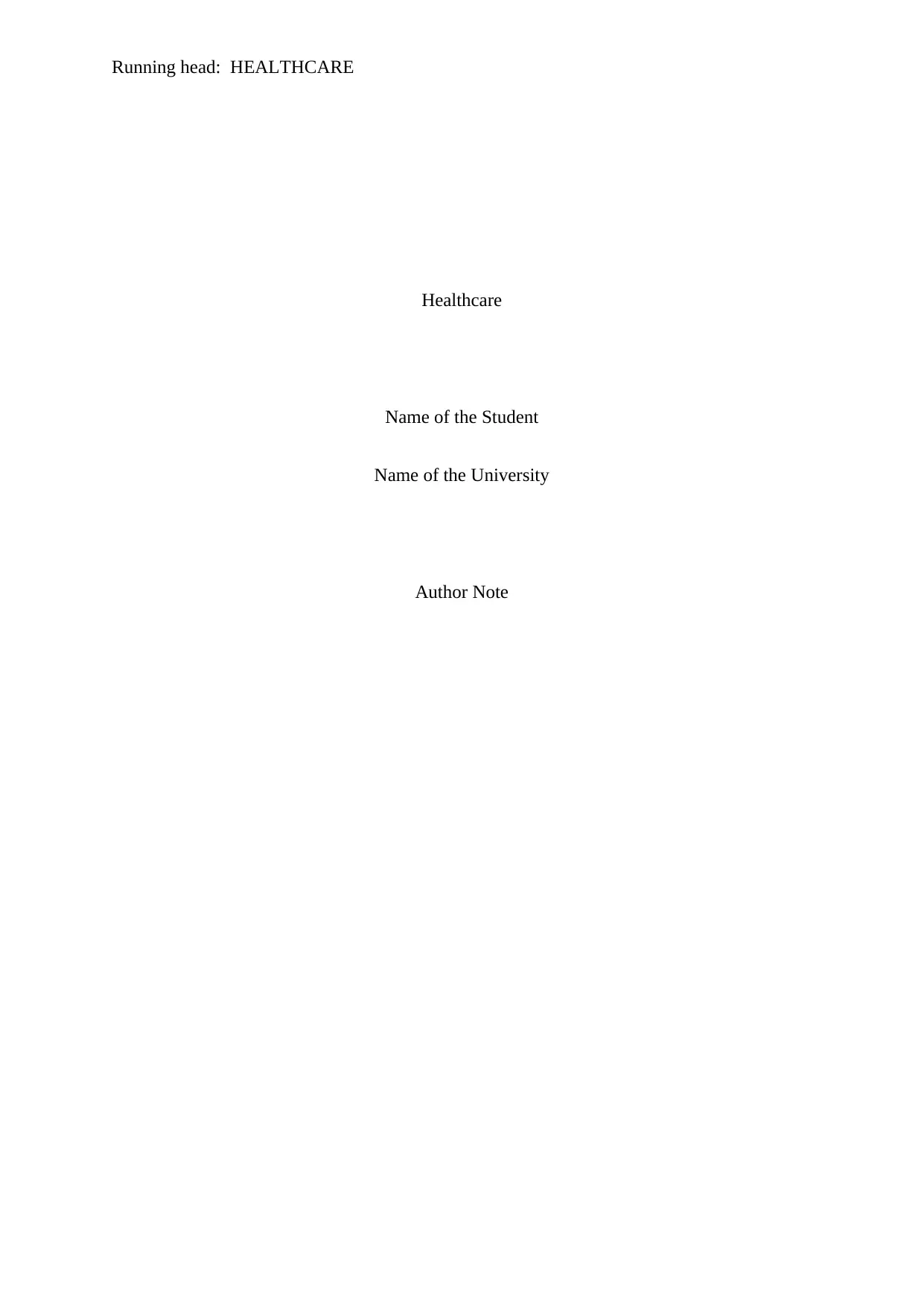
Running head: HEALTHCARE
Healthcare
Name of the Student
Name of the University
Author Note
Healthcare
Name of the Student
Name of the University
Author Note
Paraphrase This Document
Need a fresh take? Get an instant paraphrase of this document with our AI Paraphraser
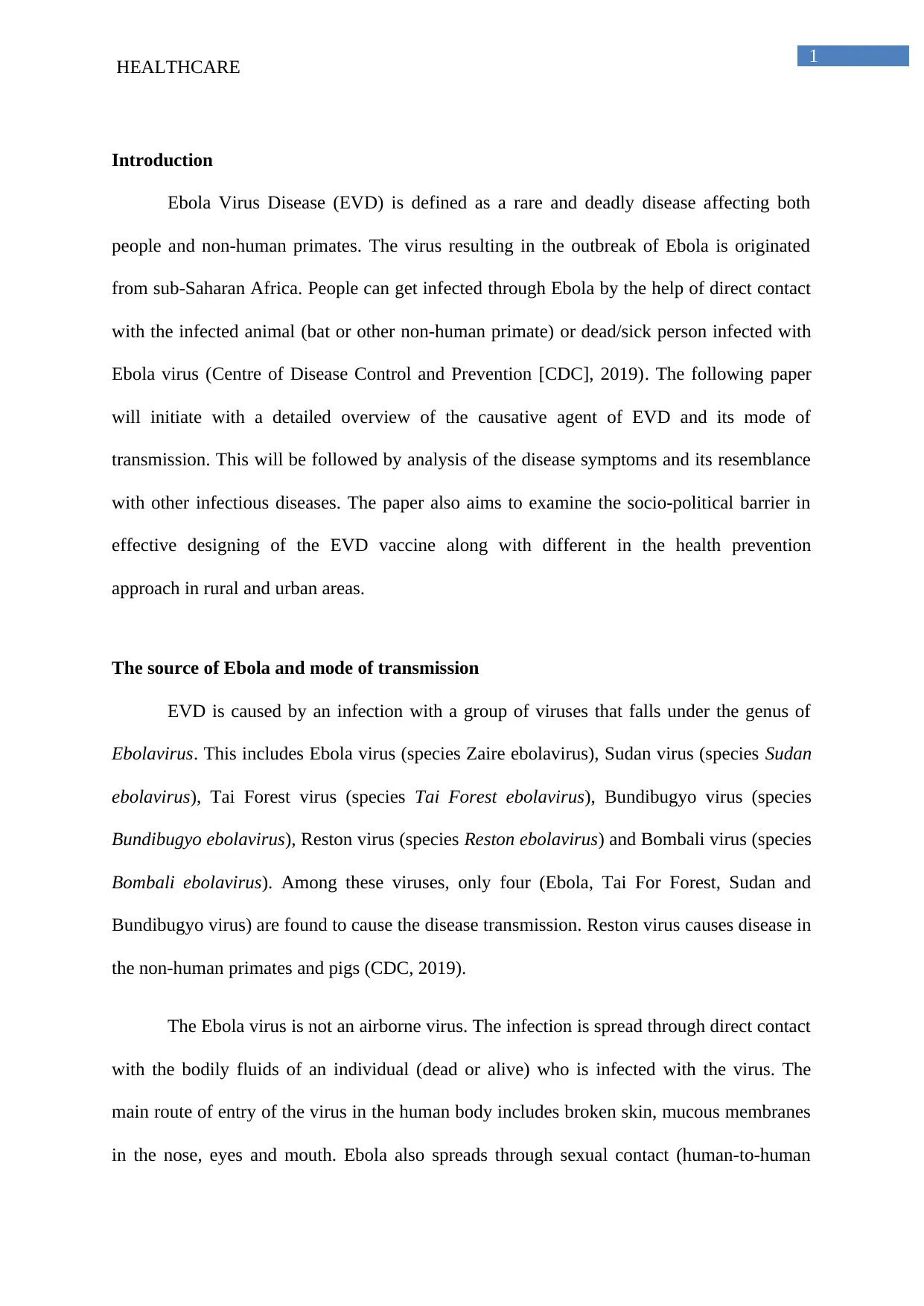
1
HEALTHCARE
Introduction
Ebola Virus Disease (EVD) is defined as a rare and deadly disease affecting both
people and non-human primates. The virus resulting in the outbreak of Ebola is originated
from sub-Saharan Africa. People can get infected through Ebola by the help of direct contact
with the infected animal (bat or other non-human primate) or dead/sick person infected with
Ebola virus (Centre of Disease Control and Prevention [CDC], 2019). The following paper
will initiate with a detailed overview of the causative agent of EVD and its mode of
transmission. This will be followed by analysis of the disease symptoms and its resemblance
with other infectious diseases. The paper also aims to examine the socio-political barrier in
effective designing of the EVD vaccine along with different in the health prevention
approach in rural and urban areas.
The source of Ebola and mode of transmission
EVD is caused by an infection with a group of viruses that falls under the genus of
Ebolavirus. This includes Ebola virus (species Zaire ebolavirus), Sudan virus (species Sudan
ebolavirus), Tai Forest virus (species Tai Forest ebolavirus), Bundibugyo virus (species
Bundibugyo ebolavirus), Reston virus (species Reston ebolavirus) and Bombali virus (species
Bombali ebolavirus). Among these viruses, only four (Ebola, Tai For Forest, Sudan and
Bundibugyo virus) are found to cause the disease transmission. Reston virus causes disease in
the non-human primates and pigs (CDC, 2019).
The Ebola virus is not an airborne virus. The infection is spread through direct contact
with the bodily fluids of an individual (dead or alive) who is infected with the virus. The
main route of entry of the virus in the human body includes broken skin, mucous membranes
in the nose, eyes and mouth. Ebola also spreads through sexual contact (human-to-human
HEALTHCARE
Introduction
Ebola Virus Disease (EVD) is defined as a rare and deadly disease affecting both
people and non-human primates. The virus resulting in the outbreak of Ebola is originated
from sub-Saharan Africa. People can get infected through Ebola by the help of direct contact
with the infected animal (bat or other non-human primate) or dead/sick person infected with
Ebola virus (Centre of Disease Control and Prevention [CDC], 2019). The following paper
will initiate with a detailed overview of the causative agent of EVD and its mode of
transmission. This will be followed by analysis of the disease symptoms and its resemblance
with other infectious diseases. The paper also aims to examine the socio-political barrier in
effective designing of the EVD vaccine along with different in the health prevention
approach in rural and urban areas.
The source of Ebola and mode of transmission
EVD is caused by an infection with a group of viruses that falls under the genus of
Ebolavirus. This includes Ebola virus (species Zaire ebolavirus), Sudan virus (species Sudan
ebolavirus), Tai Forest virus (species Tai Forest ebolavirus), Bundibugyo virus (species
Bundibugyo ebolavirus), Reston virus (species Reston ebolavirus) and Bombali virus (species
Bombali ebolavirus). Among these viruses, only four (Ebola, Tai For Forest, Sudan and
Bundibugyo virus) are found to cause the disease transmission. Reston virus causes disease in
the non-human primates and pigs (CDC, 2019).
The Ebola virus is not an airborne virus. The infection is spread through direct contact
with the bodily fluids of an individual (dead or alive) who is infected with the virus. The
main route of entry of the virus in the human body includes broken skin, mucous membranes
in the nose, eyes and mouth. Ebola also spreads through sexual contact (human-to-human
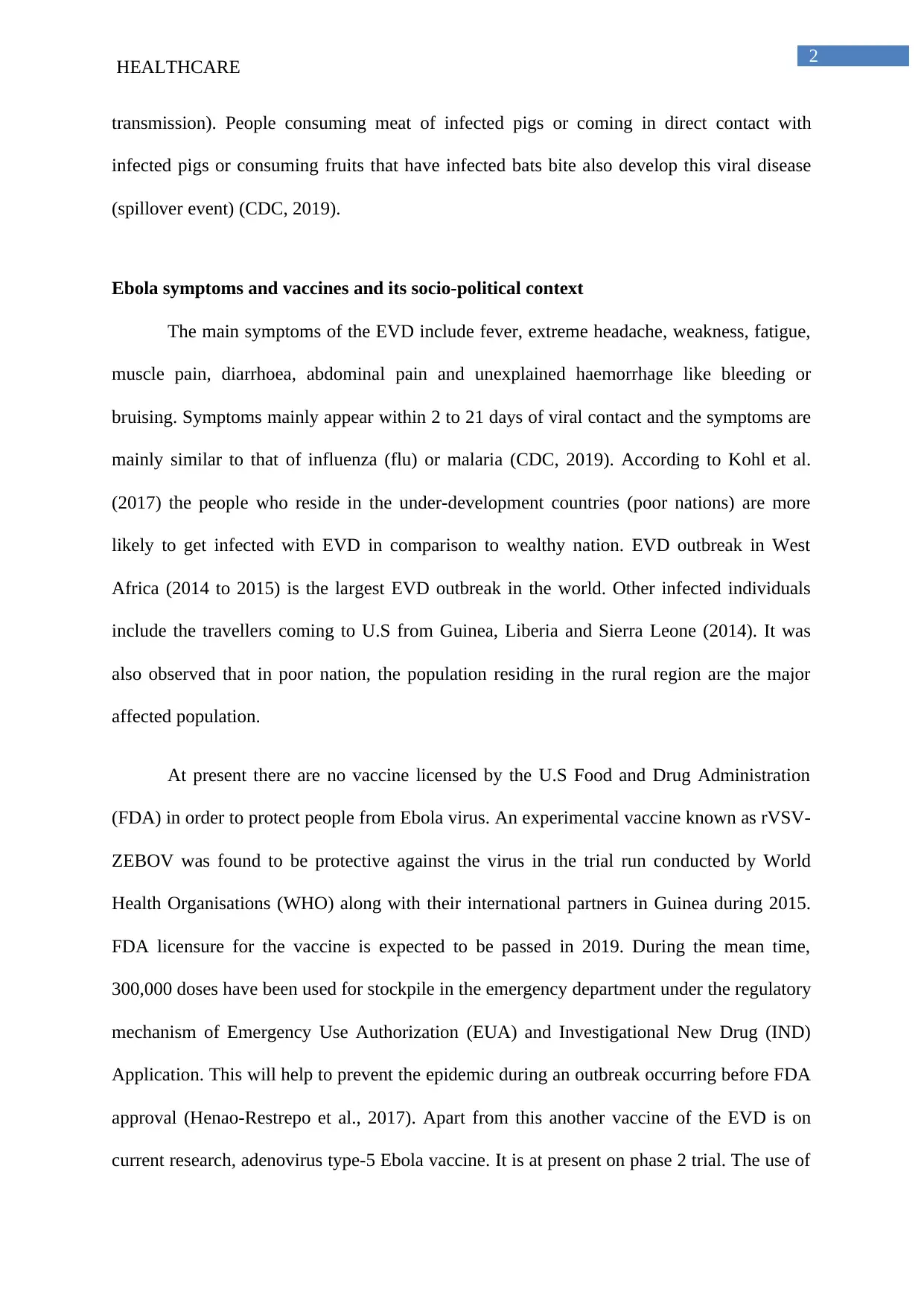
2
HEALTHCARE
transmission). People consuming meat of infected pigs or coming in direct contact with
infected pigs or consuming fruits that have infected bats bite also develop this viral disease
(spillover event) (CDC, 2019).
Ebola symptoms and vaccines and its socio-political context
The main symptoms of the EVD include fever, extreme headache, weakness, fatigue,
muscle pain, diarrhoea, abdominal pain and unexplained haemorrhage like bleeding or
bruising. Symptoms mainly appear within 2 to 21 days of viral contact and the symptoms are
mainly similar to that of influenza (flu) or malaria (CDC, 2019). According to Kohl et al.
(2017) the people who reside in the under-development countries (poor nations) are more
likely to get infected with EVD in comparison to wealthy nation. EVD outbreak in West
Africa (2014 to 2015) is the largest EVD outbreak in the world. Other infected individuals
include the travellers coming to U.S from Guinea, Liberia and Sierra Leone (2014). It was
also observed that in poor nation, the population residing in the rural region are the major
affected population.
At present there are no vaccine licensed by the U.S Food and Drug Administration
(FDA) in order to protect people from Ebola virus. An experimental vaccine known as rVSV-
ZEBOV was found to be protective against the virus in the trial run conducted by World
Health Organisations (WHO) along with their international partners in Guinea during 2015.
FDA licensure for the vaccine is expected to be passed in 2019. During the mean time,
300,000 doses have been used for stockpile in the emergency department under the regulatory
mechanism of Emergency Use Authorization (EUA) and Investigational New Drug (IND)
Application. This will help to prevent the epidemic during an outbreak occurring before FDA
approval (Henao-Restrepo et al., 2017). Apart from this another vaccine of the EVD is on
current research, adenovirus type-5 Ebola vaccine. It is at present on phase 2 trial. The use of
HEALTHCARE
transmission). People consuming meat of infected pigs or coming in direct contact with
infected pigs or consuming fruits that have infected bats bite also develop this viral disease
(spillover event) (CDC, 2019).
Ebola symptoms and vaccines and its socio-political context
The main symptoms of the EVD include fever, extreme headache, weakness, fatigue,
muscle pain, diarrhoea, abdominal pain and unexplained haemorrhage like bleeding or
bruising. Symptoms mainly appear within 2 to 21 days of viral contact and the symptoms are
mainly similar to that of influenza (flu) or malaria (CDC, 2019). According to Kohl et al.
(2017) the people who reside in the under-development countries (poor nations) are more
likely to get infected with EVD in comparison to wealthy nation. EVD outbreak in West
Africa (2014 to 2015) is the largest EVD outbreak in the world. Other infected individuals
include the travellers coming to U.S from Guinea, Liberia and Sierra Leone (2014). It was
also observed that in poor nation, the population residing in the rural region are the major
affected population.
At present there are no vaccine licensed by the U.S Food and Drug Administration
(FDA) in order to protect people from Ebola virus. An experimental vaccine known as rVSV-
ZEBOV was found to be protective against the virus in the trial run conducted by World
Health Organisations (WHO) along with their international partners in Guinea during 2015.
FDA licensure for the vaccine is expected to be passed in 2019. During the mean time,
300,000 doses have been used for stockpile in the emergency department under the regulatory
mechanism of Emergency Use Authorization (EUA) and Investigational New Drug (IND)
Application. This will help to prevent the epidemic during an outbreak occurring before FDA
approval (Henao-Restrepo et al., 2017). Apart from this another vaccine of the EVD is on
current research, adenovirus type-5 Ebola vaccine. It is at present on phase 2 trial. The use of
⊘ This is a preview!⊘
Do you want full access?
Subscribe today to unlock all pages.

Trusted by 1+ million students worldwide
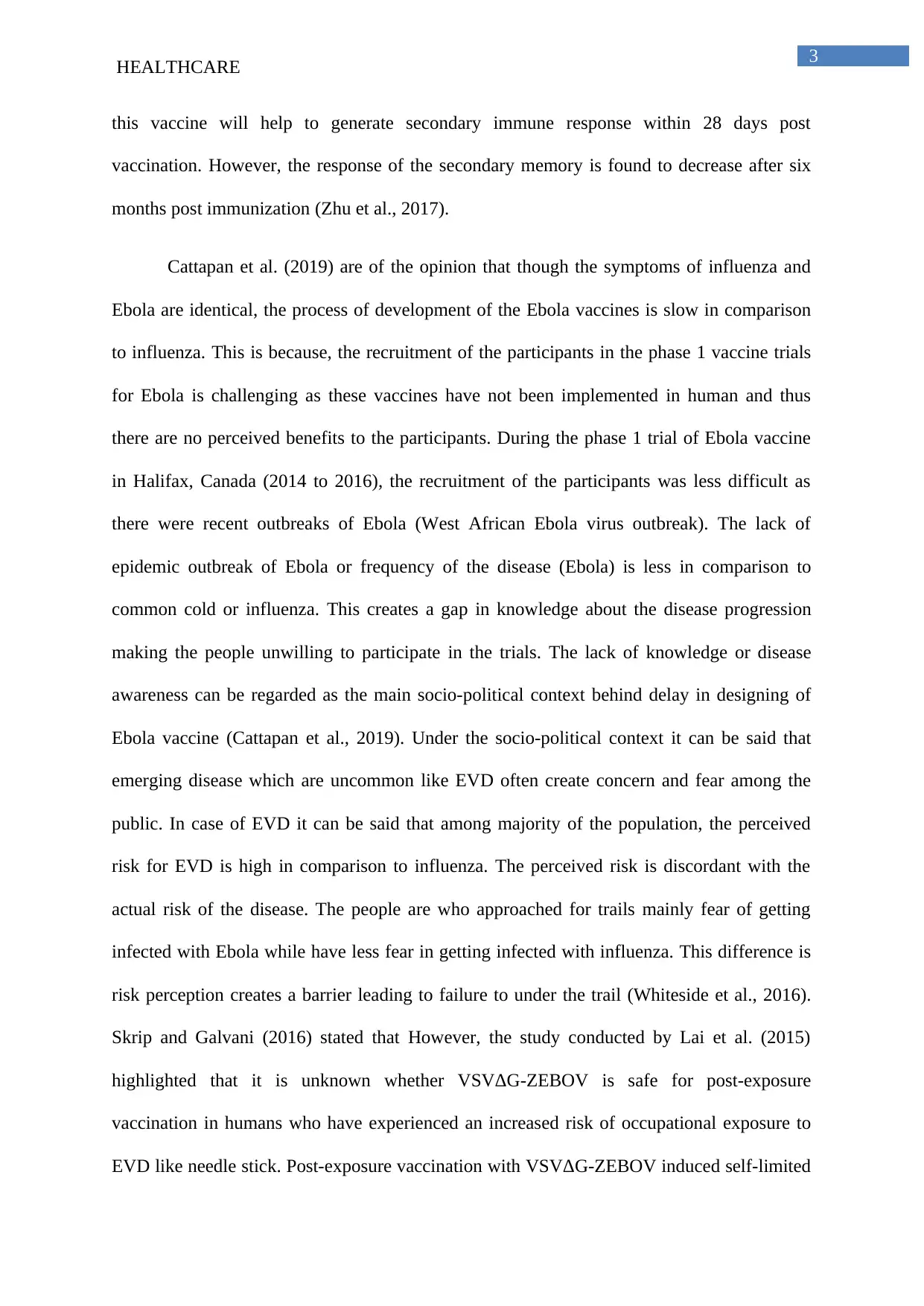
3
HEALTHCARE
this vaccine will help to generate secondary immune response within 28 days post
vaccination. However, the response of the secondary memory is found to decrease after six
months post immunization (Zhu et al., 2017).
Cattapan et al. (2019) are of the opinion that though the symptoms of influenza and
Ebola are identical, the process of development of the Ebola vaccines is slow in comparison
to influenza. This is because, the recruitment of the participants in the phase 1 vaccine trials
for Ebola is challenging as these vaccines have not been implemented in human and thus
there are no perceived benefits to the participants. During the phase 1 trial of Ebola vaccine
in Halifax, Canada (2014 to 2016), the recruitment of the participants was less difficult as
there were recent outbreaks of Ebola (West African Ebola virus outbreak). The lack of
epidemic outbreak of Ebola or frequency of the disease (Ebola) is less in comparison to
common cold or influenza. This creates a gap in knowledge about the disease progression
making the people unwilling to participate in the trials. The lack of knowledge or disease
awareness can be regarded as the main socio-political context behind delay in designing of
Ebola vaccine (Cattapan et al., 2019). Under the socio-political context it can be said that
emerging disease which are uncommon like EVD often create concern and fear among the
public. In case of EVD it can be said that among majority of the population, the perceived
risk for EVD is high in comparison to influenza. The perceived risk is discordant with the
actual risk of the disease. The people are who approached for trails mainly fear of getting
infected with Ebola while have less fear in getting infected with influenza. This difference is
risk perception creates a barrier leading to failure to under the trail (Whiteside et al., 2016).
Skrip and Galvani (2016) stated that However, the study conducted by Lai et al. (2015)
highlighted that it is unknown whether VSVΔG-ZEBOV is safe for post-exposure
vaccination in humans who have experienced an increased risk of occupational exposure to
EVD like needle stick. Post-exposure vaccination with VSVΔG-ZEBOV induced self-limited
HEALTHCARE
this vaccine will help to generate secondary immune response within 28 days post
vaccination. However, the response of the secondary memory is found to decrease after six
months post immunization (Zhu et al., 2017).
Cattapan et al. (2019) are of the opinion that though the symptoms of influenza and
Ebola are identical, the process of development of the Ebola vaccines is slow in comparison
to influenza. This is because, the recruitment of the participants in the phase 1 vaccine trials
for Ebola is challenging as these vaccines have not been implemented in human and thus
there are no perceived benefits to the participants. During the phase 1 trial of Ebola vaccine
in Halifax, Canada (2014 to 2016), the recruitment of the participants was less difficult as
there were recent outbreaks of Ebola (West African Ebola virus outbreak). The lack of
epidemic outbreak of Ebola or frequency of the disease (Ebola) is less in comparison to
common cold or influenza. This creates a gap in knowledge about the disease progression
making the people unwilling to participate in the trials. The lack of knowledge or disease
awareness can be regarded as the main socio-political context behind delay in designing of
Ebola vaccine (Cattapan et al., 2019). Under the socio-political context it can be said that
emerging disease which are uncommon like EVD often create concern and fear among the
public. In case of EVD it can be said that among majority of the population, the perceived
risk for EVD is high in comparison to influenza. The perceived risk is discordant with the
actual risk of the disease. The people are who approached for trails mainly fear of getting
infected with Ebola while have less fear in getting infected with influenza. This difference is
risk perception creates a barrier leading to failure to under the trail (Whiteside et al., 2016).
Skrip and Galvani (2016) stated that However, the study conducted by Lai et al. (2015)
highlighted that it is unknown whether VSVΔG-ZEBOV is safe for post-exposure
vaccination in humans who have experienced an increased risk of occupational exposure to
EVD like needle stick. Post-exposure vaccination with VSVΔG-ZEBOV induced self-limited
Paraphrase This Document
Need a fresh take? Get an instant paraphrase of this document with our AI Paraphraser
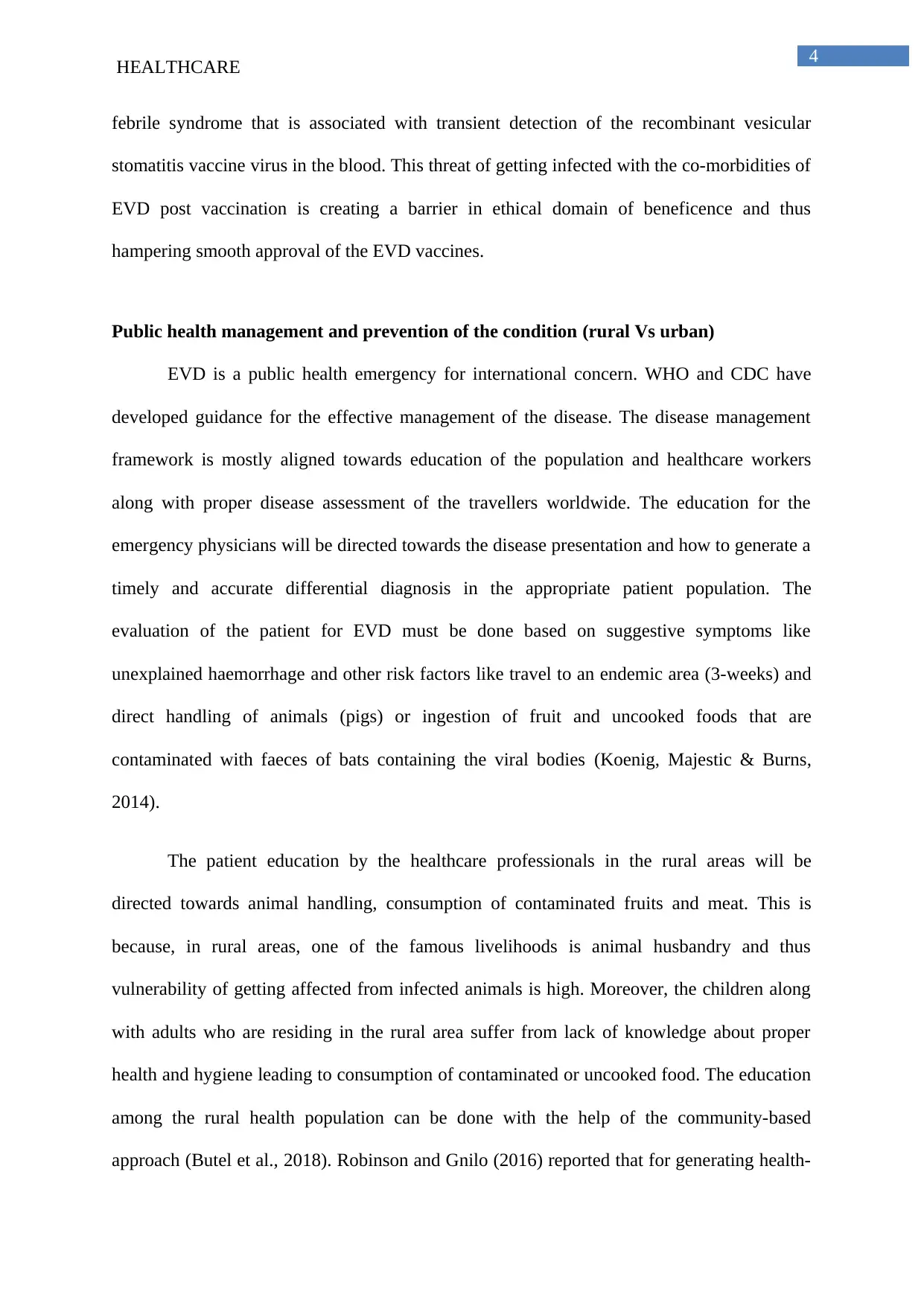
4
HEALTHCARE
febrile syndrome that is associated with transient detection of the recombinant vesicular
stomatitis vaccine virus in the blood. This threat of getting infected with the co-morbidities of
EVD post vaccination is creating a barrier in ethical domain of beneficence and thus
hampering smooth approval of the EVD vaccines.
Public health management and prevention of the condition (rural Vs urban)
EVD is a public health emergency for international concern. WHO and CDC have
developed guidance for the effective management of the disease. The disease management
framework is mostly aligned towards education of the population and healthcare workers
along with proper disease assessment of the travellers worldwide. The education for the
emergency physicians will be directed towards the disease presentation and how to generate a
timely and accurate differential diagnosis in the appropriate patient population. The
evaluation of the patient for EVD must be done based on suggestive symptoms like
unexplained haemorrhage and other risk factors like travel to an endemic area (3-weeks) and
direct handling of animals (pigs) or ingestion of fruit and uncooked foods that are
contaminated with faeces of bats containing the viral bodies (Koenig, Majestic & Burns,
2014).
The patient education by the healthcare professionals in the rural areas will be
directed towards animal handling, consumption of contaminated fruits and meat. This is
because, in rural areas, one of the famous livelihoods is animal husbandry and thus
vulnerability of getting affected from infected animals is high. Moreover, the children along
with adults who are residing in the rural area suffer from lack of knowledge about proper
health and hygiene leading to consumption of contaminated or uncooked food. The education
among the rural health population can be done with the help of the community-based
approach (Butel et al., 2018). Robinson and Gnilo (2016) reported that for generating health-
HEALTHCARE
febrile syndrome that is associated with transient detection of the recombinant vesicular
stomatitis vaccine virus in the blood. This threat of getting infected with the co-morbidities of
EVD post vaccination is creating a barrier in ethical domain of beneficence and thus
hampering smooth approval of the EVD vaccines.
Public health management and prevention of the condition (rural Vs urban)
EVD is a public health emergency for international concern. WHO and CDC have
developed guidance for the effective management of the disease. The disease management
framework is mostly aligned towards education of the population and healthcare workers
along with proper disease assessment of the travellers worldwide. The education for the
emergency physicians will be directed towards the disease presentation and how to generate a
timely and accurate differential diagnosis in the appropriate patient population. The
evaluation of the patient for EVD must be done based on suggestive symptoms like
unexplained haemorrhage and other risk factors like travel to an endemic area (3-weeks) and
direct handling of animals (pigs) or ingestion of fruit and uncooked foods that are
contaminated with faeces of bats containing the viral bodies (Koenig, Majestic & Burns,
2014).
The patient education by the healthcare professionals in the rural areas will be
directed towards animal handling, consumption of contaminated fruits and meat. This is
because, in rural areas, one of the famous livelihoods is animal husbandry and thus
vulnerability of getting affected from infected animals is high. Moreover, the children along
with adults who are residing in the rural area suffer from lack of knowledge about proper
health and hygiene leading to consumption of contaminated or uncooked food. The education
among the rural health population can be done with the help of the community-based
approach (Butel et al., 2018). Robinson and Gnilo (2016) reported that for generating health-
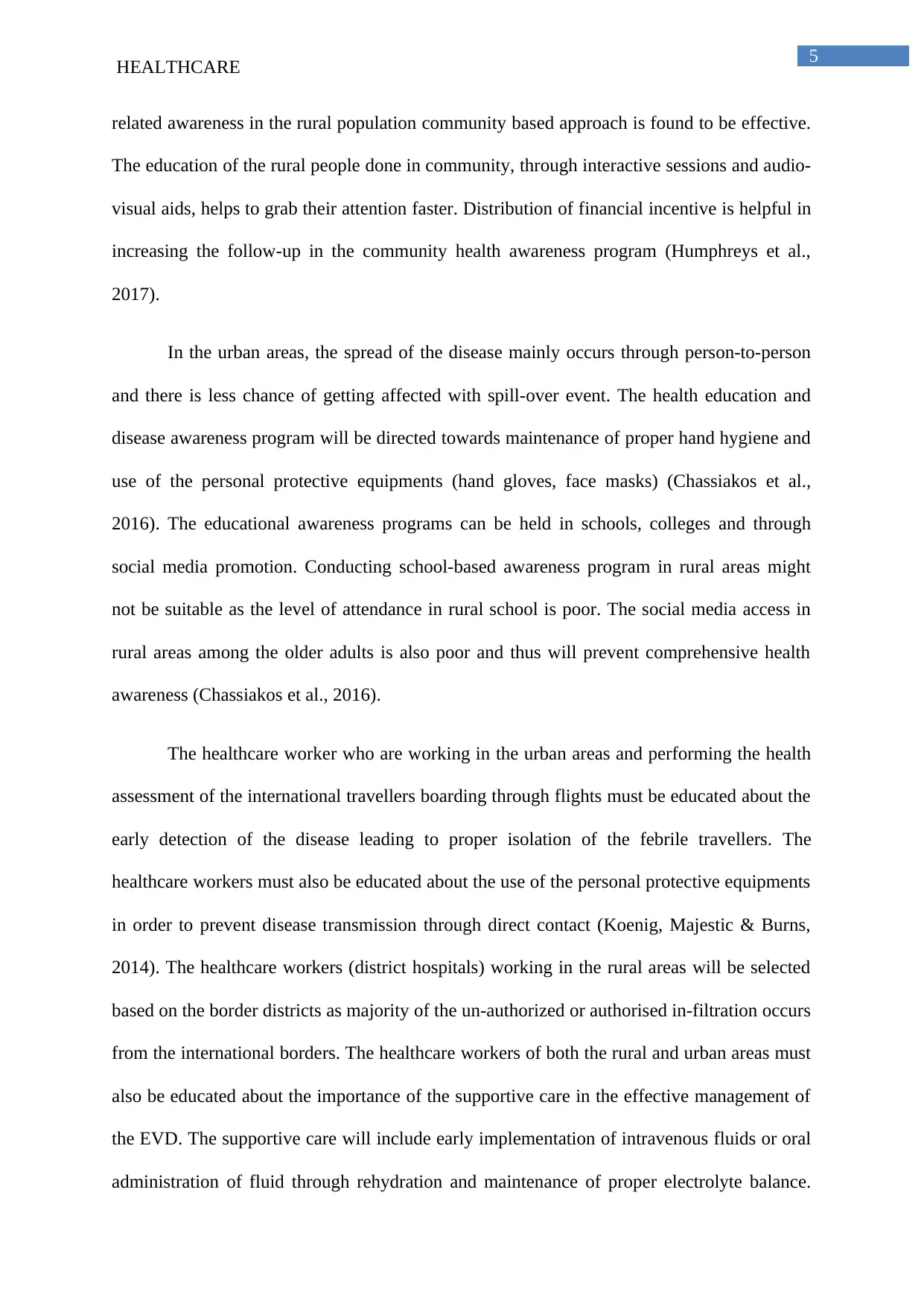
5
HEALTHCARE
related awareness in the rural population community based approach is found to be effective.
The education of the rural people done in community, through interactive sessions and audio-
visual aids, helps to grab their attention faster. Distribution of financial incentive is helpful in
increasing the follow-up in the community health awareness program (Humphreys et al.,
2017).
In the urban areas, the spread of the disease mainly occurs through person-to-person
and there is less chance of getting affected with spill-over event. The health education and
disease awareness program will be directed towards maintenance of proper hand hygiene and
use of the personal protective equipments (hand gloves, face masks) (Chassiakos et al.,
2016). The educational awareness programs can be held in schools, colleges and through
social media promotion. Conducting school-based awareness program in rural areas might
not be suitable as the level of attendance in rural school is poor. The social media access in
rural areas among the older adults is also poor and thus will prevent comprehensive health
awareness (Chassiakos et al., 2016).
The healthcare worker who are working in the urban areas and performing the health
assessment of the international travellers boarding through flights must be educated about the
early detection of the disease leading to proper isolation of the febrile travellers. The
healthcare workers must also be educated about the use of the personal protective equipments
in order to prevent disease transmission through direct contact (Koenig, Majestic & Burns,
2014). The healthcare workers (district hospitals) working in the rural areas will be selected
based on the border districts as majority of the un-authorized or authorised in-filtration occurs
from the international borders. The healthcare workers of both the rural and urban areas must
also be educated about the importance of the supportive care in the effective management of
the EVD. The supportive care will include early implementation of intravenous fluids or oral
administration of fluid through rehydration and maintenance of proper electrolyte balance.
HEALTHCARE
related awareness in the rural population community based approach is found to be effective.
The education of the rural people done in community, through interactive sessions and audio-
visual aids, helps to grab their attention faster. Distribution of financial incentive is helpful in
increasing the follow-up in the community health awareness program (Humphreys et al.,
2017).
In the urban areas, the spread of the disease mainly occurs through person-to-person
and there is less chance of getting affected with spill-over event. The health education and
disease awareness program will be directed towards maintenance of proper hand hygiene and
use of the personal protective equipments (hand gloves, face masks) (Chassiakos et al.,
2016). The educational awareness programs can be held in schools, colleges and through
social media promotion. Conducting school-based awareness program in rural areas might
not be suitable as the level of attendance in rural school is poor. The social media access in
rural areas among the older adults is also poor and thus will prevent comprehensive health
awareness (Chassiakos et al., 2016).
The healthcare worker who are working in the urban areas and performing the health
assessment of the international travellers boarding through flights must be educated about the
early detection of the disease leading to proper isolation of the febrile travellers. The
healthcare workers must also be educated about the use of the personal protective equipments
in order to prevent disease transmission through direct contact (Koenig, Majestic & Burns,
2014). The healthcare workers (district hospitals) working in the rural areas will be selected
based on the border districts as majority of the un-authorized or authorised in-filtration occurs
from the international borders. The healthcare workers of both the rural and urban areas must
also be educated about the importance of the supportive care in the effective management of
the EVD. The supportive care will include early implementation of intravenous fluids or oral
administration of fluid through rehydration and maintenance of proper electrolyte balance.
⊘ This is a preview!⊘
Do you want full access?
Subscribe today to unlock all pages.

Trusted by 1+ million students worldwide
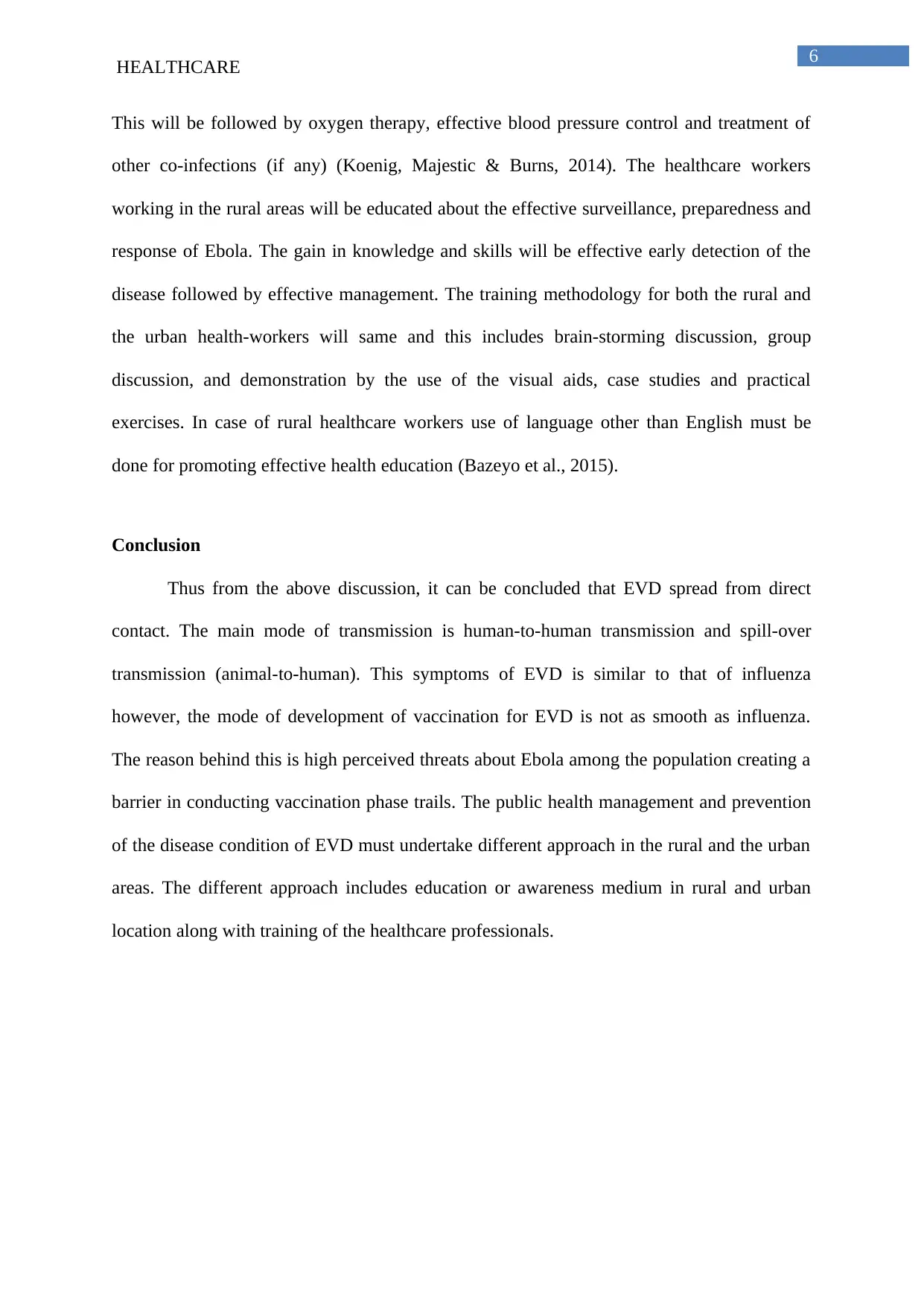
6
HEALTHCARE
This will be followed by oxygen therapy, effective blood pressure control and treatment of
other co-infections (if any) (Koenig, Majestic & Burns, 2014). The healthcare workers
working in the rural areas will be educated about the effective surveillance, preparedness and
response of Ebola. The gain in knowledge and skills will be effective early detection of the
disease followed by effective management. The training methodology for both the rural and
the urban health-workers will same and this includes brain-storming discussion, group
discussion, and demonstration by the use of the visual aids, case studies and practical
exercises. In case of rural healthcare workers use of language other than English must be
done for promoting effective health education (Bazeyo et al., 2015).
Conclusion
Thus from the above discussion, it can be concluded that EVD spread from direct
contact. The main mode of transmission is human-to-human transmission and spill-over
transmission (animal-to-human). This symptoms of EVD is similar to that of influenza
however, the mode of development of vaccination for EVD is not as smooth as influenza.
The reason behind this is high perceived threats about Ebola among the population creating a
barrier in conducting vaccination phase trails. The public health management and prevention
of the disease condition of EVD must undertake different approach in the rural and the urban
areas. The different approach includes education or awareness medium in rural and urban
location along with training of the healthcare professionals.
HEALTHCARE
This will be followed by oxygen therapy, effective blood pressure control and treatment of
other co-infections (if any) (Koenig, Majestic & Burns, 2014). The healthcare workers
working in the rural areas will be educated about the effective surveillance, preparedness and
response of Ebola. The gain in knowledge and skills will be effective early detection of the
disease followed by effective management. The training methodology for both the rural and
the urban health-workers will same and this includes brain-storming discussion, group
discussion, and demonstration by the use of the visual aids, case studies and practical
exercises. In case of rural healthcare workers use of language other than English must be
done for promoting effective health education (Bazeyo et al., 2015).
Conclusion
Thus from the above discussion, it can be concluded that EVD spread from direct
contact. The main mode of transmission is human-to-human transmission and spill-over
transmission (animal-to-human). This symptoms of EVD is similar to that of influenza
however, the mode of development of vaccination for EVD is not as smooth as influenza.
The reason behind this is high perceived threats about Ebola among the population creating a
barrier in conducting vaccination phase trails. The public health management and prevention
of the disease condition of EVD must undertake different approach in the rural and the urban
areas. The different approach includes education or awareness medium in rural and urban
location along with training of the healthcare professionals.
Paraphrase This Document
Need a fresh take? Get an instant paraphrase of this document with our AI Paraphraser
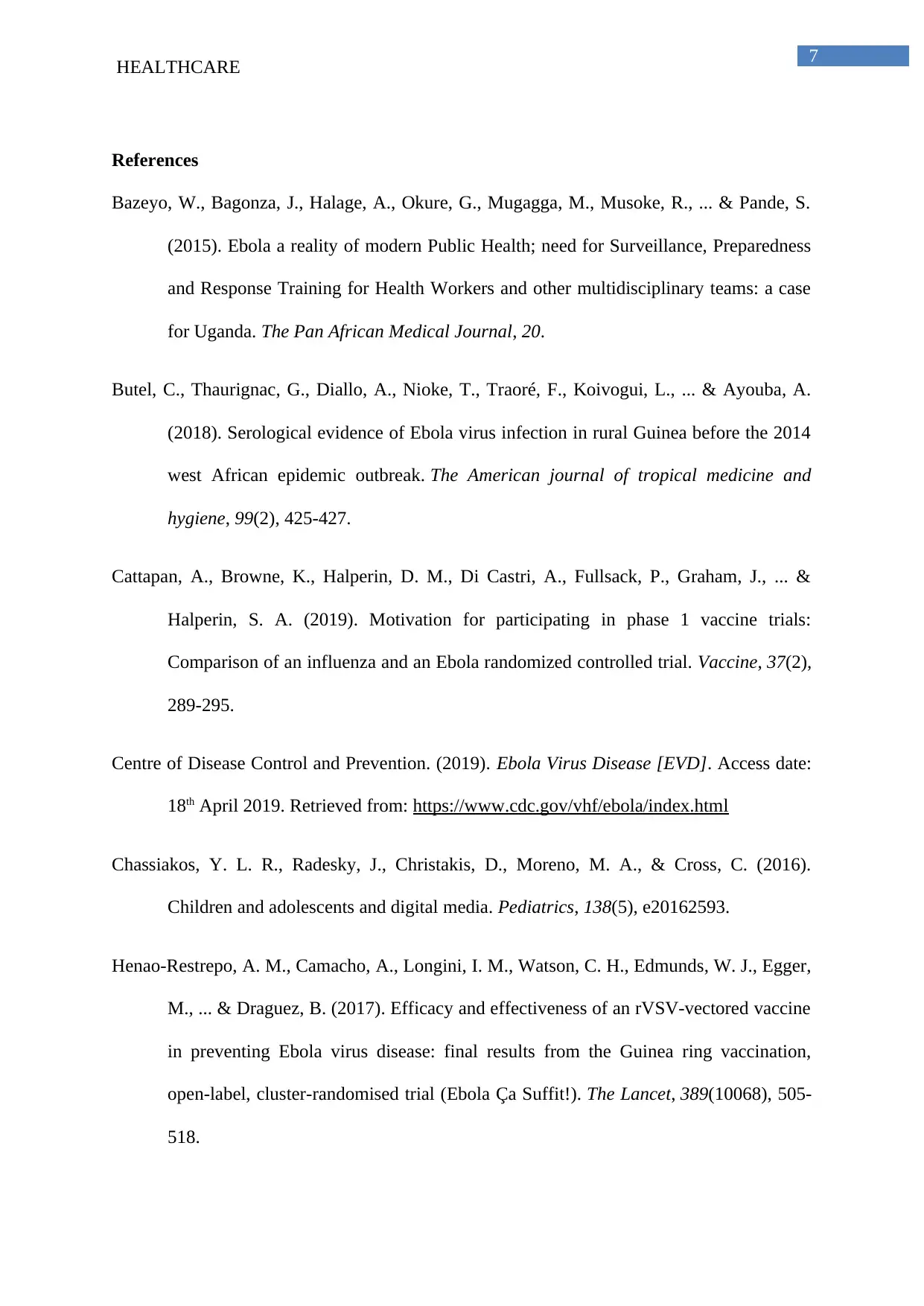
7
HEALTHCARE
References
Bazeyo, W., Bagonza, J., Halage, A., Okure, G., Mugagga, M., Musoke, R., ... & Pande, S.
(2015). Ebola a reality of modern Public Health; need for Surveillance, Preparedness
and Response Training for Health Workers and other multidisciplinary teams: a case
for Uganda. The Pan African Medical Journal, 20.
Butel, C., Thaurignac, G., Diallo, A., Nioke, T., Traoré, F., Koivogui, L., ... & Ayouba, A.
(2018). Serological evidence of Ebola virus infection in rural Guinea before the 2014
west African epidemic outbreak. The American journal of tropical medicine and
hygiene, 99(2), 425-427.
Cattapan, A., Browne, K., Halperin, D. M., Di Castri, A., Fullsack, P., Graham, J., ... &
Halperin, S. A. (2019). Motivation for participating in phase 1 vaccine trials:
Comparison of an influenza and an Ebola randomized controlled trial. Vaccine, 37(2),
289-295.
Centre of Disease Control and Prevention. (2019). Ebola Virus Disease [EVD]. Access date:
18th April 2019. Retrieved from: https://www.cdc.gov/vhf/ebola/index.html
Chassiakos, Y. L. R., Radesky, J., Christakis, D., Moreno, M. A., & Cross, C. (2016).
Children and adolescents and digital media. Pediatrics, 138(5), e20162593.
Henao-Restrepo, A. M., Camacho, A., Longini, I. M., Watson, C. H., Edmunds, W. J., Egger,
M., ... & Draguez, B. (2017). Efficacy and effectiveness of an rVSV-vectored vaccine
in preventing Ebola virus disease: final results from the Guinea ring vaccination,
open-label, cluster-randomised trial (Ebola Ça Suffit!). The Lancet, 389(10068), 505-
518.
HEALTHCARE
References
Bazeyo, W., Bagonza, J., Halage, A., Okure, G., Mugagga, M., Musoke, R., ... & Pande, S.
(2015). Ebola a reality of modern Public Health; need for Surveillance, Preparedness
and Response Training for Health Workers and other multidisciplinary teams: a case
for Uganda. The Pan African Medical Journal, 20.
Butel, C., Thaurignac, G., Diallo, A., Nioke, T., Traoré, F., Koivogui, L., ... & Ayouba, A.
(2018). Serological evidence of Ebola virus infection in rural Guinea before the 2014
west African epidemic outbreak. The American journal of tropical medicine and
hygiene, 99(2), 425-427.
Cattapan, A., Browne, K., Halperin, D. M., Di Castri, A., Fullsack, P., Graham, J., ... &
Halperin, S. A. (2019). Motivation for participating in phase 1 vaccine trials:
Comparison of an influenza and an Ebola randomized controlled trial. Vaccine, 37(2),
289-295.
Centre of Disease Control and Prevention. (2019). Ebola Virus Disease [EVD]. Access date:
18th April 2019. Retrieved from: https://www.cdc.gov/vhf/ebola/index.html
Chassiakos, Y. L. R., Radesky, J., Christakis, D., Moreno, M. A., & Cross, C. (2016).
Children and adolescents and digital media. Pediatrics, 138(5), e20162593.
Henao-Restrepo, A. M., Camacho, A., Longini, I. M., Watson, C. H., Edmunds, W. J., Egger,
M., ... & Draguez, B. (2017). Efficacy and effectiveness of an rVSV-vectored vaccine
in preventing Ebola virus disease: final results from the Guinea ring vaccination,
open-label, cluster-randomised trial (Ebola Ça Suffit!). The Lancet, 389(10068), 505-
518.
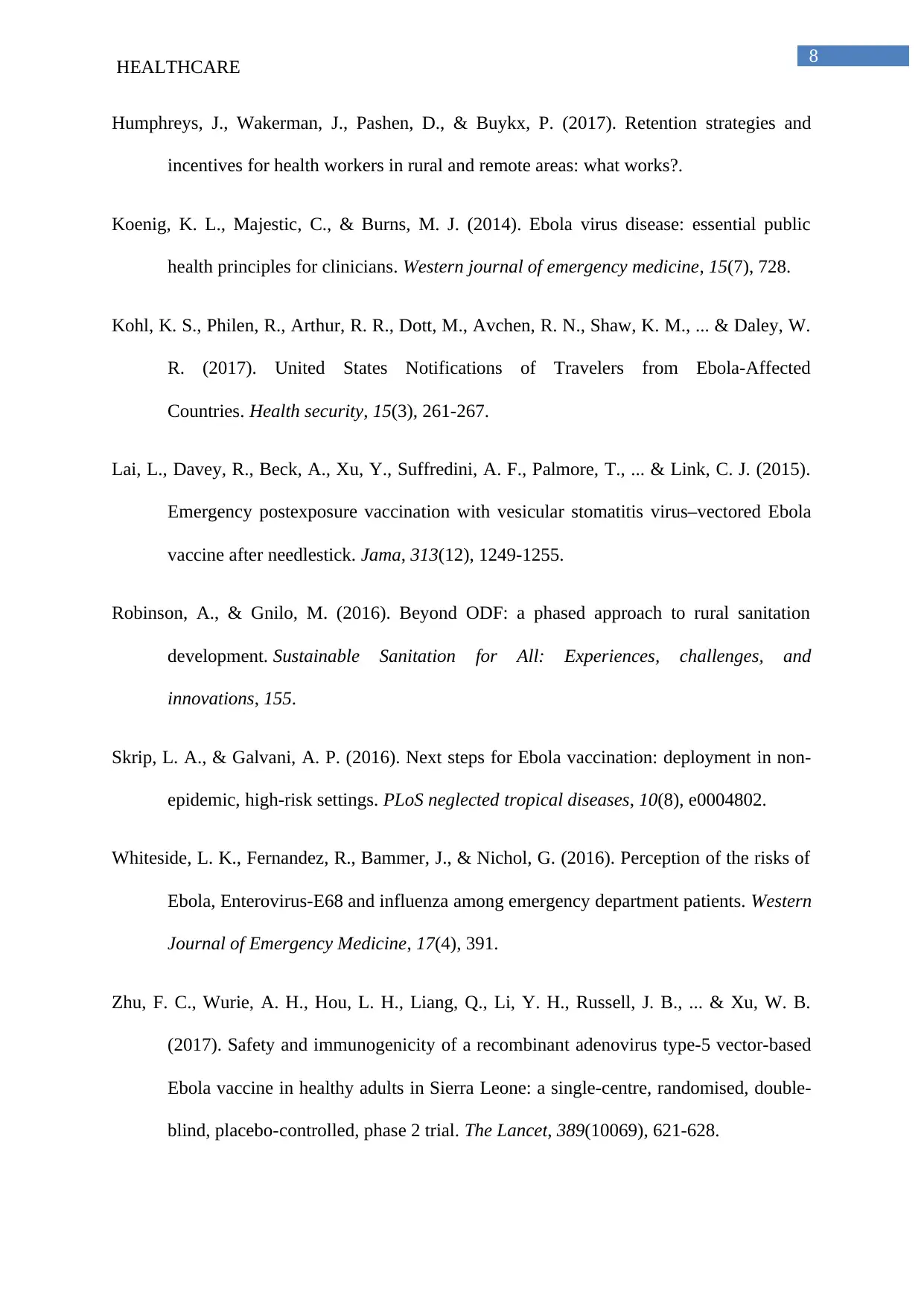
8
HEALTHCARE
Humphreys, J., Wakerman, J., Pashen, D., & Buykx, P. (2017). Retention strategies and
incentives for health workers in rural and remote areas: what works?.
Koenig, K. L., Majestic, C., & Burns, M. J. (2014). Ebola virus disease: essential public
health principles for clinicians. Western journal of emergency medicine, 15(7), 728.
Kohl, K. S., Philen, R., Arthur, R. R., Dott, M., Avchen, R. N., Shaw, K. M., ... & Daley, W.
R. (2017). United States Notifications of Travelers from Ebola-Affected
Countries. Health security, 15(3), 261-267.
Lai, L., Davey, R., Beck, A., Xu, Y., Suffredini, A. F., Palmore, T., ... & Link, C. J. (2015).
Emergency postexposure vaccination with vesicular stomatitis virus–vectored Ebola
vaccine after needlestick. Jama, 313(12), 1249-1255.
Robinson, A., & Gnilo, M. (2016). Beyond ODF: a phased approach to rural sanitation
development. Sustainable Sanitation for All: Experiences, challenges, and
innovations, 155.
Skrip, L. A., & Galvani, A. P. (2016). Next steps for Ebola vaccination: deployment in non-
epidemic, high-risk settings. PLoS neglected tropical diseases, 10(8), e0004802.
Whiteside, L. K., Fernandez, R., Bammer, J., & Nichol, G. (2016). Perception of the risks of
Ebola, Enterovirus-E68 and influenza among emergency department patients. Western
Journal of Emergency Medicine, 17(4), 391.
Zhu, F. C., Wurie, A. H., Hou, L. H., Liang, Q., Li, Y. H., Russell, J. B., ... & Xu, W. B.
(2017). Safety and immunogenicity of a recombinant adenovirus type-5 vector-based
Ebola vaccine in healthy adults in Sierra Leone: a single-centre, randomised, double-
blind, placebo-controlled, phase 2 trial. The Lancet, 389(10069), 621-628.
HEALTHCARE
Humphreys, J., Wakerman, J., Pashen, D., & Buykx, P. (2017). Retention strategies and
incentives for health workers in rural and remote areas: what works?.
Koenig, K. L., Majestic, C., & Burns, M. J. (2014). Ebola virus disease: essential public
health principles for clinicians. Western journal of emergency medicine, 15(7), 728.
Kohl, K. S., Philen, R., Arthur, R. R., Dott, M., Avchen, R. N., Shaw, K. M., ... & Daley, W.
R. (2017). United States Notifications of Travelers from Ebola-Affected
Countries. Health security, 15(3), 261-267.
Lai, L., Davey, R., Beck, A., Xu, Y., Suffredini, A. F., Palmore, T., ... & Link, C. J. (2015).
Emergency postexposure vaccination with vesicular stomatitis virus–vectored Ebola
vaccine after needlestick. Jama, 313(12), 1249-1255.
Robinson, A., & Gnilo, M. (2016). Beyond ODF: a phased approach to rural sanitation
development. Sustainable Sanitation for All: Experiences, challenges, and
innovations, 155.
Skrip, L. A., & Galvani, A. P. (2016). Next steps for Ebola vaccination: deployment in non-
epidemic, high-risk settings. PLoS neglected tropical diseases, 10(8), e0004802.
Whiteside, L. K., Fernandez, R., Bammer, J., & Nichol, G. (2016). Perception of the risks of
Ebola, Enterovirus-E68 and influenza among emergency department patients. Western
Journal of Emergency Medicine, 17(4), 391.
Zhu, F. C., Wurie, A. H., Hou, L. H., Liang, Q., Li, Y. H., Russell, J. B., ... & Xu, W. B.
(2017). Safety and immunogenicity of a recombinant adenovirus type-5 vector-based
Ebola vaccine in healthy adults in Sierra Leone: a single-centre, randomised, double-
blind, placebo-controlled, phase 2 trial. The Lancet, 389(10069), 621-628.
⊘ This is a preview!⊘
Do you want full access?
Subscribe today to unlock all pages.

Trusted by 1+ million students worldwide
1 out of 9
Related Documents
Your All-in-One AI-Powered Toolkit for Academic Success.
+13062052269
info@desklib.com
Available 24*7 on WhatsApp / Email
![[object Object]](/_next/static/media/star-bottom.7253800d.svg)
Unlock your academic potential
Copyright © 2020–2025 A2Z Services. All Rights Reserved. Developed and managed by ZUCOL.




